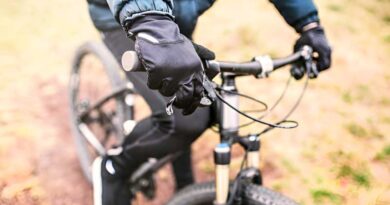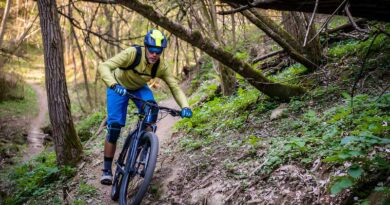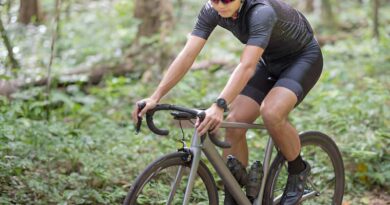Best Mountain Bikes for Big Guys of 2025
Finding the right mountain bike can be hard if you’re a bigger rider. Not all bikes offer enough support. You need a strong frame, wide tires, and a comfortable seat. A good bike should handle your weight and still ride smooth. It also needs strong brakes and solid suspension. The right fit makes every ride better and safer. We’ve put together a list of the best mountain bikes for heavy riders. These bikes are built tough and ride great. Whether you’re just starting out or riding trails every weekend, we’ve got options. Let’s help you find a bike that fits you well and gives you confidence on every ride.
1. Huffy Stone Mountain Hardtail Mountain Bike
-
Frame: Steel hardtail frame
-
Suspension: Front suspension fork
-
Gearing: 18-speed twist shifters with Shimano rear derailleur
-
Wheel Size: 26 inches
-
Brakes: Linear pull hand brakes
The Huffy Stone Mountain Hardtail is a solid entry-level mountain bike designed for casual trails and light off-road use. With an 18-speed setup and Shimano derailleur, it offers enough versatility for most beginner rides. The steel frame feels sturdy and absorbs small bumps reasonably well, though it does add some weight. Its front suspension fork helps smooth out minor terrain inconsistencies, and the 26-inch wheels give it a good balance of control and agility.
While it’s not built for hardcore trails or aggressive riding, the Huffy Stone Mountain is perfect for leisurely rides through parks or beginner paths. The twist shifters work fine for casual use, though they’re not as responsive under load. The brakes are reliable in dry conditions, but they lack stopping power in wet or muddy environments. Overall, it’s a great value bike for newcomers looking to get into mountain biking without breaking the bank.
Pros:
-
Budget-friendly
-
Sturdy steel frame
-
Smooth ride on light trails
-
Decent gear range for casual use
-
Easy to assemble
Cons:
-
Heavier than aluminum bikes
-
Brakes could perform better in wet conditions
-
Not suitable for rugged terrain
2. Dynacraft Magna Echo Ridge Mountain Bike
-
Frame: Steel hardtail frame
-
Suspension: Front fork suspension
-
Gearing: 18-speed with handlebar grip shifters
-
Wheel Size: 24 inches
-
Brakes: Front and rear linear pull brakes
The Dynacraft Magna Echo Ridge is a compact and affordable option ideal for younger riders or smaller adults looking to explore mild off-road trails. Its 24-inch wheels make it easy to control, while the 18-speed grip shifters provide a decent range for climbing hills or cruising on flat ground. The steel frame offers durability, and the front suspension absorbs light bumps well enough for casual riding.
This bike shines in parks, bike paths, and easy dirt trails. However, it’s not ideal for rugged terrain or advanced use. The brakes do their job in good conditions, but like most linear pull brakes, they’re not the strongest in wet or muddy environments. Still, for the price, it’s a dependable starter bike for riders who want to dip their toes into mountain biking.
Pros:
-
Great for beginners and teens
-
Sturdy frame with a comfortable ride
-
Smooth gear changes
-
Good value for money
-
Eye-catching design
Cons:
-
Brakes lack power in wet conditions
-
Smaller wheel size limits speed
-
Not suitable for advanced trails
3. Ktaxon Mountain Bike 26/27.5 Inch
-
Frame: High-carbon steel
-
Suspension: Dual suspension system (front and rear)
-
Gearing: 21-speed with Shimano derailleurs
-
Wheel Size: 26 or 27.5 inches
-
Brakes: Front and rear disc brakes
The Ktaxon Mountain Bike stands out with its dual suspension and wide gear range, making it a capable option for bumpy trails and mixed terrain. With both front and rear suspension, it offers a cushioned ride that absorbs shocks well on rocky paths and forest routes. The 21-speed Shimano gear system shifts smoothly, and the choice of 26 or 27.5-inch wheels allows for some customization based on rider height and terrain preference.
Disc brakes provide reliable stopping power, especially in wet or muddy conditions, which adds a layer of safety on trickier trails. The high-carbon steel frame is tough, though it does make the bike a bit heavier. Overall, the Ktaxon is a solid option for riders wanting more than just a basic hardtail, without spending a fortune.
Pros:
-
Dual suspension improves comfort
-
Reliable disc brakes
-
Smooth gear changes
-
Great for varied terrain
-
Customizable wheel size
Cons:
-
Heavier than aluminum options
-
Assembly can be tricky
-
Paint may chip easily
4. MarKnig 26 Inch Fat Tire Mountain Bike
Technical Specs:
-
Frame: High-carbon steel frame
-
Suspension: Front suspension fork
-
Gearing: 21-speed with Shimano derailleurs
-
Wheel Size: 26 inches with 4-inch fat tires
-
Brakes: Dual disc brakes
The MarKnig Fat Tire Mountain Bike is built for stability and traction on rough or loose terrain. Its 4-inch-wide tires grip well on sand, snow, and gravel, making it a great pick for riders who love off-the-beaten-path adventures. The high-carbon steel frame adds durability and strength, while the 21-speed drivetrain helps manage different trail conditions and inclines.
Despite its heavier build, the MarKnig handles surprisingly well thanks to the fat tires that cushion every bump. It’s ideal for adventure seekers and casual riders who want to explore beaches, forest trails, or snowy paths. The dual disc brakes are dependable and provide consistent braking in all weather conditions. While it’s not a speed machine, it delivers fun and comfort where many bikes would struggle.
Pros:
-
Excellent traction on loose surfaces
-
Very stable and smooth ride
-
Great for snow, sand, and trail use
-
Strong dual disc brakes
-
Rugged design
Cons:
-
Heavier than most bikes
-
Not built for high-speed riding
-
Bulky for urban use
5. WEIZE Mountain Bike
Technical Specs:
-
Frame: Aluminum alloy frame
-
Suspension: Front suspension fork
-
Gearing: 21-speed Shimano drivetrain
-
Wheel Size: 27.5 inches
-
Brakes: Dual disc brakes
The WEIZE Mountain Bike is a versatile, mid-range bike that offers solid performance on trails and everyday paths. Its lightweight aluminum frame makes it easier to handle compared to steel models, and the front suspension fork provides decent shock absorption for light to moderate trail riding. With a 21-speed Shimano setup, the bike handles elevation changes smoothly.
27.5-inch wheels strike a good balance between control and speed, while the dual disc brakes add stopping confidence in both dry and wet conditions. This bike is ideal for those looking for a bit more than an entry-level ride without diving into high-end pricing. It’s comfortable, responsive, and stylish — great for commuters who want weekend trail capability.
Pros:
-
Lightweight and agile
-
Smooth and responsive gear shifts
-
Strong disc braking system
-
Good for mixed use (trail and urban)
-
Easy to handle
Cons:
-
Front suspension only
-
Assembly instructions can be unclear
-
Saddle may need upgrading
5. Schwinn High Timber Mountain Bike
Technical Specs:
-
Frame: Steel or aluminum options
-
Suspension: Front suspension fork
-
Gearing: 21-speed Shimano twist shifters
-
Wheel Size: 24, 26, or 27.5 inches
-
Brakes: Front and rear linear pull brakes
The Schwinn High Timber is a reliable and customizable mountain bike available in multiple frame materials and wheel sizes. It’s a trusted name for good reason — the bike performs well for recreational trail rides and casual commuting. The 21-speed gear system is smooth and intuitive, while the front suspension fork helps with light bumps and uneven paths.
This is a great all-rounder for beginners and intermediate riders who want versatility and comfort. The twist shifters are responsive, and while the linear pull brakes are basic, they get the job done on dry ground. If you’re after a dependable bike from a known brand, this is an easy choice — just choose the size that fits your frame and ride style best.
Pros:
-
Reputable brand with good build quality
-
Multiple size and frame options
-
Comfortable and easy to ride
-
Affordable for most budgets
-
Great for recreational use
Cons:
-
Brakes aren’t ideal in wet weather
-
Heavier steel models available
-
Not for technical trails
7. Grafton Mountain Bike
Technical Specs:
-
Frame: Aluminum alloy
-
Suspension: Front suspension fork
-
Gearing: 21-speed with Shimano components
-
Wheel Size: 27.5 inches
-
Brakes: Dual mechanical disc brakes
The Grafton Mountain Bike offers a refined riding experience with a clean design and quality components. Its aluminum alloy frame keeps the weight down, which helps with agility and speed. The 21-speed Shimano gear system is reliable and offers flexibility on a variety of inclines and terrain types. Dual disc brakes deliver consistent stopping power even when the trails get muddy or wet.
This bike is perfect for someone who wants a well-balanced ride for commuting, weekend trail rides, or fitness. The 27.5-inch wheels are a good size for mixed terrain, providing speed and stability. It doesn’t have a rear suspension, so it’s better suited for moderate trails than highly technical routes. Overall, it’s a stylish and dependable bike with excellent value for money.
Pros:
-
Lightweight and agile frame
-
Smooth gear transitions
-
Good braking in all conditions
-
Suitable for trail and road use
-
Sleek modern design
Cons:
-
No rear suspension
-
Pedals may need upgrading
-
Not ideal for extreme downhill riding
How to Choose Mountain Bikes: A Beginner’s Guide
Choosing the right mountain bike can be a bit overwhelming, especially if you are a bigger man. With so many types, brands, and features available, it’s easy to get lost in technical jargon and marketing buzzwords. But don’t worry — whether you’re brand new to mountain biking or looking to upgrade, this guide will help you understand what really matters so you can pick the perfect ride.
1. Know Your Riding Style
The first thing you should consider is how and where you plan to ride. Different mountain bikes are built for different terrain and riding styles. Here’s a quick breakdown:
-
Cross-Country (XC): Best for fast, uphill rides and long distances. These bikes are lightweight, efficient climbers, and ideal for smoother trails.
-
Trail: The most versatile type of mountain bike. Great for mixed terrain, from smooth trails to rough descents. Perfect for casual riders and weekend warriors.
-
Enduro / All-Mountain: Designed for aggressive downhill riding but still capable of climbing. These are more robust and built for technical trails.
-
Downhill: Made for one thing — going down steep, gnarly trails fast. Not ideal for climbing or everyday use.
-
Hardtail vs. Full Suspension: Hardtails have a suspension fork at the front only, while full-suspension bikes have both front and rear suspension. Hardtails are lighter and cheaper. Full-suspension bikes are more comfortable and capable on rough terrain.
Think about your local trails, your skill level, and your fitness. You don’t need a downhill bike if you’re mostly riding smooth woodland paths.
2. Choose the Right Frame Size
For obese people, a properly fitting bike is crucial for comfort and control. Most manufacturers provide sizing charts based on your height or inseam. The frame size affects your reach, your handling, and even how safe you feel on descents.
Here’s a rough guide based on rider height:
-
5’0” – 5’4”: Small (15” – 16” frame)
-
5’4” – 5’7”: Medium (16” – 17” frame)
-
5’7” – 5’10”: Large (17” – 18” frame)
-
5’10” – 6’1”: X-Large (19” – 20” frame)
-
6’1” and up: XXL (21”+ frame)
Always test ride a bike if possible. If it feels cramped or too stretched out, try the next size up or down.
3. Understand Suspension Types
Mountain bikes come with different suspension setups:
-
Hardtail (front suspension only): Good for beginners, smoother trails, and budget riders. Easier to maintain and lighter.
-
Full Suspension: More comfort and control over rough terrain. Better for technical descents but usually more expensive.
Your riding terrain should guide this choice. If you’re riding rocky, rooty trails or want to hit bike parks, full suspension is worth it. For smoother singletrack or commuting, a hardtail is just fine.
4. Wheel Size Matters
There are three main mountain bike wheel sizes:
-
26-inch: Becoming outdated. Smaller, lighter, and more nimble.
-
27.5-inch (650B): A middle ground offering good agility and better rollover than 26”.
-
29-inch: Great for speed and rolling over obstacles. Popular in XC and trail bikes.
For most riders today, 27.5” and 29” are the top choices. Taller riders often prefer 29” wheels, while shorter riders may feel more comfortable with 27.5”.
5. Check the Gearing
Mountain bikes have come a long way in terms of drivetrains. Today, most modern MTBs use a 1x drivetrain (single front chainring), which is simpler and lighter. You’ll typically see:
-
1×10, 1×11, or 1×12 setups — the more gears on the cassette, the more versatile your range.
-
2x or 3x setups are older, heavier, and more complicated, but some entry-level bikes still use them.
Look for a wide-range cassette (like 11-51T) if you want help climbing steep hills.
6. Brakes: Go Hydraulic
There are two types of disc brakes:
-
Mechanical Disc Brakes: Cable-operated. Decent stopping power, but harder to modulate.
-
Hydraulic Disc Brakes: Fluid-based, powerful, and consistent. Much better performance, especially in wet or muddy conditions.
Hydraulic brakes are worth the extra cost if you’re riding serious trails. They offer far better control, especially on steep descents.
7. Frame Material: Aluminum or Carbon?
Most mountain bikes are made from:
-
Aluminum: Affordable, durable, and relatively lightweight. Great for most riders.
-
Carbon Fiber: Lighter and stiffer, but more expensive. Often found on high-end bikes.
-
Steel or Titanium: Less common. Steel is heavy but comfortable. Titanium is light and strong but very expensive.
If you’re on a budget, go with aluminum. If you’re racing or chasing performance, carbon might be worth the investment.
8. Dropper Post? Yes, Please
A dropper seatpost lets you lower your saddle on the fly. This helps with steep descents and technical sections, giving you better control.
It’s a game-changer if you ride technical trails or like flowy descents. Many mid-range bikes now include droppers as standard.
9. Pay Attention to Components
Mountain bikes come with a mix of parts from brands like Shimano or SRAM. Entry-level bikes usually come with:
-
Shimano Deore or SRAM SX/NX
-
Mid-range: SLX / XT or GX
-
High-end: XTR or XX1
Also check the fork — brands like RockShox and Fox make quality suspension forks. Cheaper bikes may come with heavier, less effective suspension.
Don’t stress over every detail, but know that better components often mean smoother shifting, lighter weight, and longer-lasting performance.
10. Budget: Spend Smart
Here’s a rough idea of what to expect:
-
Under £500 / $600: Entry-level hardtails. Good for casual trail riding and beginners.
-
£600–£1,200 / $700–$1,500: Better hardtails and entry-level full suspension. Great value zone.
-
£1,200–£2,500 / $1,500–$3,000: Mid-range full suspension bikes with good components.
-
£2,500+ / $3,000+: High-end bikes, carbon frames, top-tier suspension, and racing performance.
Don’t blow your budget on the fanciest frame and then skimp on safety gear. Make sure you leave room for a helmet, gloves, multitool, spare tube, and a hydration pack.
Final Thoughts
Choosing the right mountain bike for tall persons is all about balancing your needs, your budget, and your riding goals. Start by thinking about where you’ll ride and what kind of bike suits that terrain. Prioritize frame fit and geometry, then consider things like suspension, wheels, gearing, and brakes.
You don’t need the most expensive bike to have a great time on the trail. A well-chosen mid-range bike with good fit and features will take you far — and with a bit of trail time, you’ll quickly figure out what upgrades are worth it down the line.
So test a few bikes, ask questions at your local shop, and get ready to hit the trails. Your perfect mountain bike is out there — and the adventure starts the moment you hop on the saddle.




